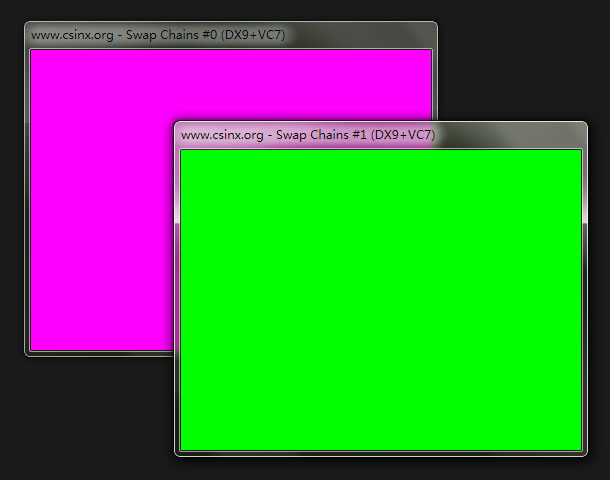在DirectX程序中我们可以通过创建交换链将共享的资源绘制在不同的窗口里。
我们先看以下创建交换链的代码:
//********************************************************************
// Filename: Main.cpp
// Author: Chinafish
// Modifier: Chinafish
// Created: 2010-06-25 14:36
// Updated: 2010-06-25 14:36
// QQ: 149200849
// MSN: china_fish@msn.com
// Purpose: Render to multiple windows using swap chains.
//====================================================================
// Copyright(C) 2004-2010 by Chinafish. All Rights Reserved.
//********************************************************************
#define STRICT
#define WIN32_LEAN_AND_MEAN
#include "windows.h"
// Link D3D
#include "d3d9.h"
#pragma comment(lib, "d3d9.lib")
#define Release_Safe(p){if(p!=NULL) p->Release();}
#define WINDOW_TITLE_0 "www.csinx.org - Swap Chains #0 (DX9+VC7)"
#define WINDOW_TITLE_1 "www.csinx.org - Swap Chains #1 (DX9+VC7)"
#define WINDOW_WIDTH 800
#define WINDOW_HEIGHT 600
//-----------------------------------------------------------------------------
// GLOBALS
//-----------------------------------------------------------------------------
HWND g_hWnd_0 = NULL; // Handle to the first window
HWND g_hWnd_1 = NULL; // Handle to the second window
LPDIRECT3D9 g_pD3D = NULL;
LPDIRECT3DDEVICE9 g_pd3dDevice = NULL;
LPDIRECT3DSWAPCHAIN9 g_swapChain_0 = NULL; // Direct3D device, which supports
LPDIRECT3DSWAPCHAIN9 g_swapChain_1 = NULL; // two swap chains.
D3DPRESENT_PARAMETERS g_d3dpp;
//-----------------------------------------------------------------------------
// PROTOTYPES
//-----------------------------------------------------------------------------
int WINAPI WinMain(HINSTANCE hInstance, HINSTANCE hPrevInstance,LPSTR lpCmdLine, int nCmdShow);
LRESULT CALLBACK WindowProc(HWND hwnd, UINT uMsg, WPARAM wParam, LPARAM lParam);
void InitD3D();
void ShutDown(void);
void Render_0(void);
void Render_1(void);
//-----------------------------------------------------------------------------
// Name: WinMain()
// Desc: The application's entry point
//-----------------------------------------------------------------------------
int WINAPI WinMain(HINSTANCE hInstance, HINSTANCE hPrevInstance, LPSTR lpCmdLine, int nCmdShow)
{
WNDCLASSEX winClass;
MSG uMsg;
memset(&uMsg,0,sizeof(uMsg));
winClass.lpszClassName = "CLASS_SWAPCHAINS";
winClass.cbSize = sizeof(WNDCLASSEX);
winClass.style = CS_HREDRAW | CS_VREDRAW;
winClass.lpfnWndProc = WindowProc;
winClass.hInstance = hInstance;
winClass.hIcon = LoadIcon(hInstance, (LPCTSTR)NULL);
winClass.hIconSm = LoadIcon(hInstance, (LPCTSTR)NULL);
winClass.hCursor = LoadCursor(NULL, IDC_ARROW);
winClass.hbrBackground = (HBRUSH)GetStockObject(BLACK_BRUSH);
winClass.lpszMenuName = NULL;
winClass.cbClsExtra = 0;
winClass.cbWndExtra = 0;
if(!RegisterClassEx(&winClass))
return E_FAIL;
//
// Create window #0...
//
g_hWnd_0 = CreateWindowEx(NULL, "CLASS_SWAPCHAINS",
WINDOW_TITLE_0,
WS_EX_TOPMOST, 0, 0,
WINDOW_WIDTH, WINDOW_HEIGHT, NULL, NULL,
hInstance, NULL);
if(g_hWnd_0 == NULL)
return E_FAIL;
// Adjust window
RECT rect_0 = { 0, 0, WINDOW_WIDTH, WINDOW_HEIGHT };
AdjustWindowRect(&rect_0, GetWindowLong(g_hWnd_0, GWL_STYLE), FALSE);
SetWindowPos(g_hWnd_0, 0, 0, 0, rect_0.right - rect_0.left, rect_0.bottom - rect_0.top,
SWP_NOZORDER | SWP_NOMOVE);
ShowWindow(g_hWnd_0, nCmdShow);
UpdateWindow(g_hWnd_0);
//
// Create window #1...
//
g_hWnd_1 = CreateWindowEx(NULL, "CLASS_SWAPCHAINS",
WINDOW_TITLE_1,
WS_EX_TOPMOST, 300, 200,
WINDOW_WIDTH, WINDOW_HEIGHT, NULL, NULL,
hInstance, NULL);
if(g_hWnd_1 == NULL)
return E_FAIL;
// Adjust window
RECT rect_1 = { 0, 0, WINDOW_WIDTH, WINDOW_HEIGHT };
AdjustWindowRect(&rect_1, GetWindowLong(g_hWnd_1, GWL_STYLE), FALSE);
SetWindowPos(g_hWnd_1, 0, 0, 0, rect_1.right - rect_1.left, rect_1.bottom - rect_1.top,
SWP_NOZORDER | SWP_NOMOVE);
ShowWindow(g_hWnd_1, nCmdShow);
UpdateWindow(g_hWnd_1);
// Init D3D
InitD3D();
while(uMsg.message != WM_QUIT)
{
if(PeekMessage(&uMsg, NULL, 0, 0, PM_REMOVE))
{
TranslateMessage(&uMsg);
DispatchMessage(&uMsg);
}
else
{
// Render a frame
Render_0();
Render_1();
}
}
ShutDown();
UnregisterClass("CLASS_SWAPCHAINS", winClass.hInstance);
return uMsg.wParam;
}
//-----------------------------------------------------------------------------
// Name: WindowProc()
// Desc: The window's message handler
//-----------------------------------------------------------------------------
LRESULT CALLBACK WindowProc(HWND hWnd, UINT msg, WPARAM wParam, LPARAM lParam)
{
switch(msg)
{
case WM_KEYDOWN:
{
switch(wParam)
{
case VK_ESCAPE:
PostQuitMessage(0);
break;
}
}
break;
case WM_CLOSE:
{
PostQuitMessage(0);
}
case WM_DESTROY:
{
PostQuitMessage(0);
}
break;
default:
{
return DefWindowProc(hWnd, msg, wParam, lParam);
}
break;
}
return 0;
}
//-----------------------------------------------------------------------------
// Name: InitD3D()
// Desc: This function will only be called once during the application's
// initialization phase. Therefore, it can't contain any resources that
// need to be restored every time the Direct3D device is lost or the
// window is resized.
//-----------------------------------------------------------------------------
void InitD3D()
{
// Create D3D
g_pD3D = Direct3DCreate9(D3D_SDK_VERSION);
if(!g_pD3D)
{
MessageBox(NULL, "Direct3DCreate9() - Failed!", "Error", NULL);
return;
}
D3DDISPLAYMODE d3ddm;
g_pD3D->GetAdapterDisplayMode(D3DADAPTER_DEFAULT, &d3ddm);
ZeroMemory(&g_d3dpp, sizeof(g_d3dpp));
g_d3dpp.Windowed = TRUE;
g_d3dpp.SwapEffect = D3DSWAPEFFECT_DISCARD;
g_d3dpp.BackBufferFormat = d3ddm.Format;
g_d3dpp.EnableAutoDepthStencil = TRUE;
g_d3dpp.AutoDepthStencilFormat = D3DFMT_D16;
g_d3dpp.PresentationInterval = D3DPRESENT_INTERVAL_IMMEDIATE;
g_pD3D->CreateDevice(D3DADAPTER_DEFAULT, D3DDEVTYPE_HAL,
g_hWnd_0, D3DCREATE_SOFTWARE_VERTEXPROCESSING,
&g_d3dpp, &g_pd3dDevice);
if(!g_pd3dDevice)
{
return;
}
//
// Create additional swap chains for use by multiple windows...
//
// After CreateDevice, the first swap chain already exists, so just get it...
g_pd3dDevice->GetSwapChain(0, &g_swapChain_0);
// But the second one will need to be explicitly created...
g_pd3dDevice->CreateAdditionalSwapChain(&g_d3dpp, &g_swapChain_1);
}
//-----------------------------------------------------------------------------
// Name: ShutDown()
// Desc: Release all
//-----------------------------------------------------------------------------
void ShutDown(void)
{
Release_Safe(g_swapChain_0);
Release_Safe(g_swapChain_1);
Release_Safe(g_pd3dDevice);
Release_Safe(g_pD3D);
}
//-----------------------------------------------------------------------------
// Name: Render_0()
// Desc: Render something you want
//-----------------------------------------------------------------------------
void Render_0(void)
{
// Tell the Direct3D device to render to the first swap chain抯 back buffer
LPDIRECT3DSURFACE9 pBackBuffer = NULL;
g_swapChain_0->GetBackBuffer(0, D3DBACKBUFFER_TYPE_MONO, &pBackBuffer);
g_pd3dDevice->SetRenderTarget(0, pBackBuffer);
// Clear screen with D3DCOLOR_XRGB(255, 0, 255)
g_pd3dDevice->Clear(0, NULL, D3DCLEAR_TARGET, D3DCOLOR_XRGB(255, 0, 255), 1.0f, 0);
g_pd3dDevice->BeginScene();
// Render geometry here...
g_pd3dDevice->EndScene();
// Present swap chain #0 to window #0
g_swapChain_0->Present(NULL, NULL, g_hWnd_0, NULL, 0);
pBackBuffer->Release();
}
//-----------------------------------------------------------------------------
// Name: Render_1()
// Desc: Render something you want
//-----------------------------------------------------------------------------
void Render_1(void)
{
// Tell the Direct3D device to render to the second swap chain抯 back buffer
LPDIRECT3DSURFACE9 pBackBuffer = NULL;
g_swapChain_1->GetBackBuffer(0, D3DBACKBUFFER_TYPE_MONO, &pBackBuffer);
g_pd3dDevice->SetRenderTarget(0, pBackBuffer);
// Clear screen with D3DCOLOR_XRGB(0, 255, 0)
g_pd3dDevice->Clear(0, NULL, D3DCLEAR_TARGET, D3DCOLOR_XRGB(0, 255, 0), 1.0f, 0);
g_pd3dDevice->BeginScene();
// Render geometry here...
g_pd3dDevice->EndScene();
// Present swap chain #1 to window #1
g_swapChain_1->Present(NULL, NULL, g_hWnd_1, NULL, 0);
pBackBuffer->Release();
}
框架代码我们在前面已经有说明,这里需要说明的是在创建设备后D3D已默认存在一个交换链,可以通过调用 IDirect3DDevice9::GetSwapChain 方法得到第一个交换链。 再通过调用 IDirect3DDevice9::CreateAdditionalSwapChain 方法创建第二个交换链。
在渲染之前通过调用 IDirect3DSwapChain9::GetBackBuffer 方法取得交换链后台缓冲,通过 IDirect3DDevice9::SetRenderTarget 方法设置新的缓冲区,最后通过调用 IDirect3DSwapChain9::Present 方法将交换链内容渲染到指定的窗口中。
下图为本例代码执行效果:
